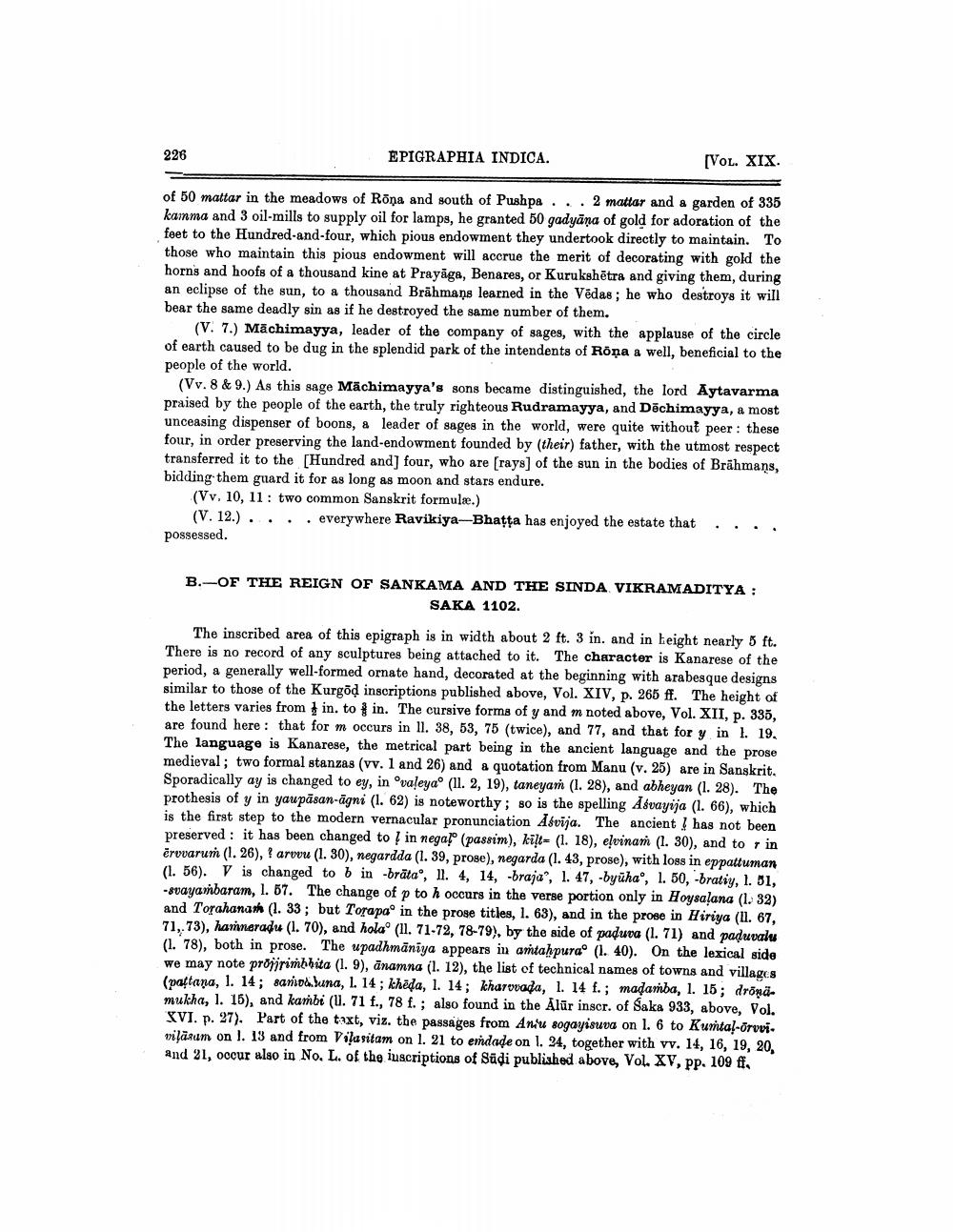________________
226
EPIGRAPHIA INDICA.
[Vol. XIX
of 50 mattar in the meadows of Rõna and south of Pushpa ... 2 mattar and a garden of 335 kamma and 3 oil-mills to supply oil for lamps, he granted 50 gadyana of gold for adoration of the feet to the Hundred-and-four, which pious endowment they undertook directly to maintain. To those who maintain this pious endowment will accrue the merit of decorating with gold the horns and hoofs of a thousand kine at Prayāga, Benares, or Kurukshētra and giving them, during an eclipse of the sun, to a thousand Brāhmaṇs learned in the Vēdas; he who destroys it will bear the same deadly sin as if he destroyed the same number of them.
(V. 7.) Māchimayya, leader of the company of sages, with the applause of the circle of earth caused to be dug in the splendid park of the intendents of Rona a well, beneficial to the people of the world.
(Vv. 8 & 9.) As this sage Māchimayya's sons became distinguished, the lord Aytavarma praised by the people of the earth, the truly righteous Rudramayya, and Döchimayya, a most unceasing dispenser of boons, a leader of sages in the world, were quite without peer: these four, in order preserving the land-endowment founded by (their) father, with the utmost respect transferred it to the [Hundred and four, who are rays of the sun in the bodies of Brähmans, bidding them guard it for as long as moon and stars endure.
(Vv. 10, 11: two common Sanskrit formulae.)
(V. 12.) .... everywhere Ravikiya--Bhatta has enjoyed the estate that .. ., possessed.
B.-OF THE REIGN OF SANKAMA AND THE SINDA VIKRAMADITYA :
SAKA 1102
The inscribed area of this epigraph is in width about 2 ft. 3 in. and in Leight nearly 5 ft. There is no record of any sculptures being attached to it. The character is Kanarese of the period, a generally well-formed ornate hand, decorated at the beginning with arabesque designs similar to those of the Kurgod inscriptions published above, Vol. XIV, p. 266 ff. The height of the letters varies from in. toin. The cursive forms of y and m noted above, Vol. XII, p. 335, are found here : that for m occurs in 11. 38, 53, 75 (twice), and 77, and that for y in l. 19. The language is Kanarese, the metrical part being in the ancient language and the prose medieval; two formal stanzas (vv. 1 and 26) and & quotation from Manu (v. 25) are in Sanskrit. Sporadically ay is changed to ey, in ovaleyao (ll. 2, 19), taneyam (1. 28), and abheyan (1. 28). The prothesis of yin yaupāsan-āgni (1. 62) is noteworthy; so is the spelling Advayija (1. 66), which is the first step to the modern vernacular pronunciation Advija. The ancient has not been preserved : it has been changed to in negal (passim), ki?t= (1. 18), elvinar (1. 30), and to rin ēruvarum (1. 26), ? arvuu (1. 30), negardda (1.39, prose), negarda (1. 43, prose), with loss in eppattuman (1. 56). V is changed to b in -brāta°, .4, 14, -braja', 1. 47, -byūha°, . 50, -bratiy, l. 31, -svayambaram, 1. 67. The change of p to h occurs in the verse portion only in Hoysalana (1. 32) and Torahanarh (1.33; but Torapa in the proge titles, 1. 63), and in the prose in Hiriya (11. 67, 71, 73), hanneradu (1. 70), and holao (11. 71-72, 78-79), by the side of paduva (1. 71) and paduvalu (1. 78), both in prose. The upadhmānīya appears in artahpurao (1.40). On the lexical side we may note projisimbhita (1. 9), anamna il. 12), the list of technical names of towns and villages (pattana, 1. 14; sanoa luna, 1. 14; khēda, 1. 14; kharvvada, 1. 14 f. ; madanba, 1. 15; dronamukha, 1. 15), and kambi (U. 71 f., 78 f. ; also found in the Alūr inscr. of Saka 933, above, Vol.
XVI. p. 27). Part of the text, viz. the passages from Anu sogayisuva on 1. 6 to Kurtal-orvvi. vilāsum on I. 13 and from Vilasitam on 1. 21 to eṁdade on 1. 24, together with vv. 14, 16, 19, 20, and 21, occur algo in No. L. of the iuscriptions of Südi published above, Vol. XV, pp. 109 fi,




